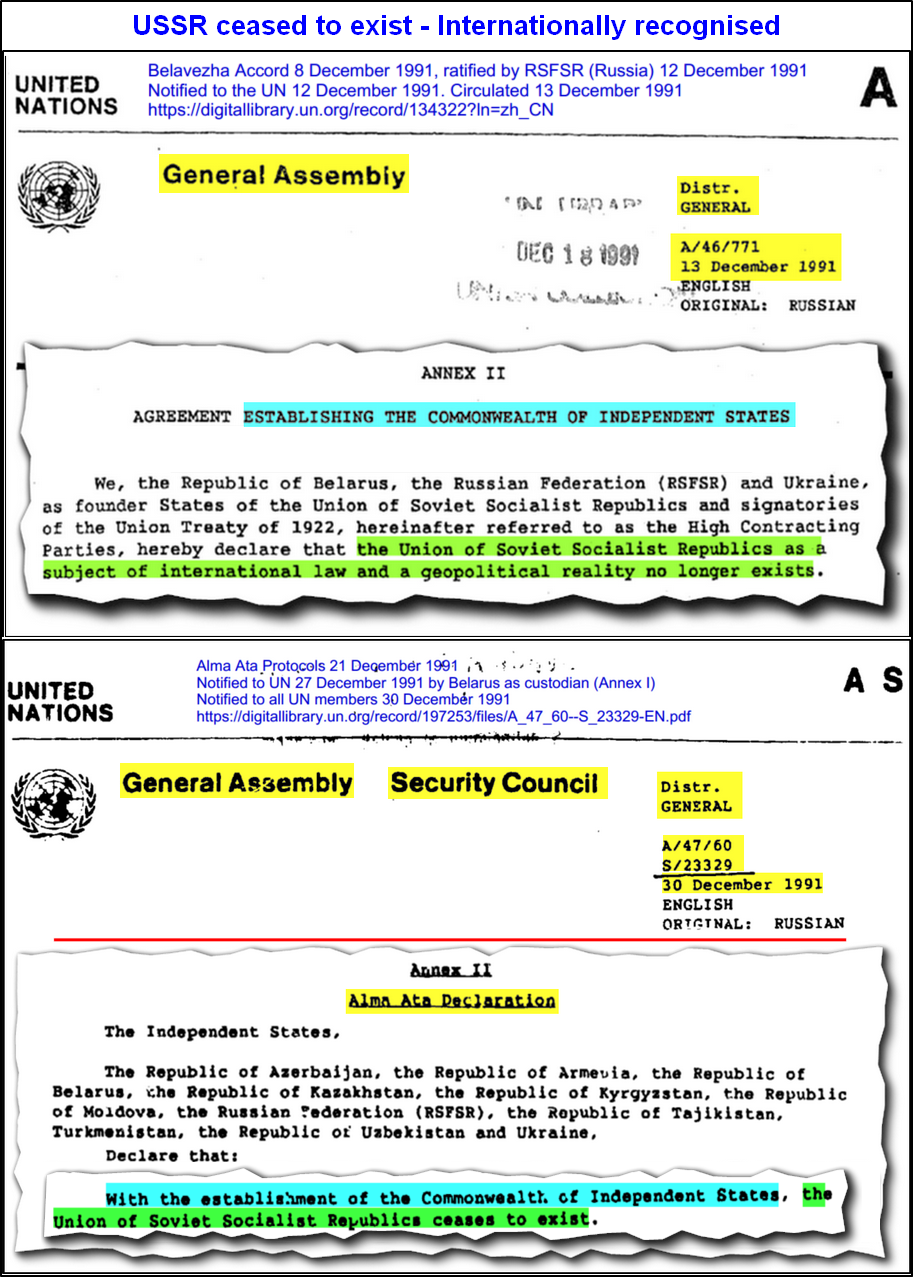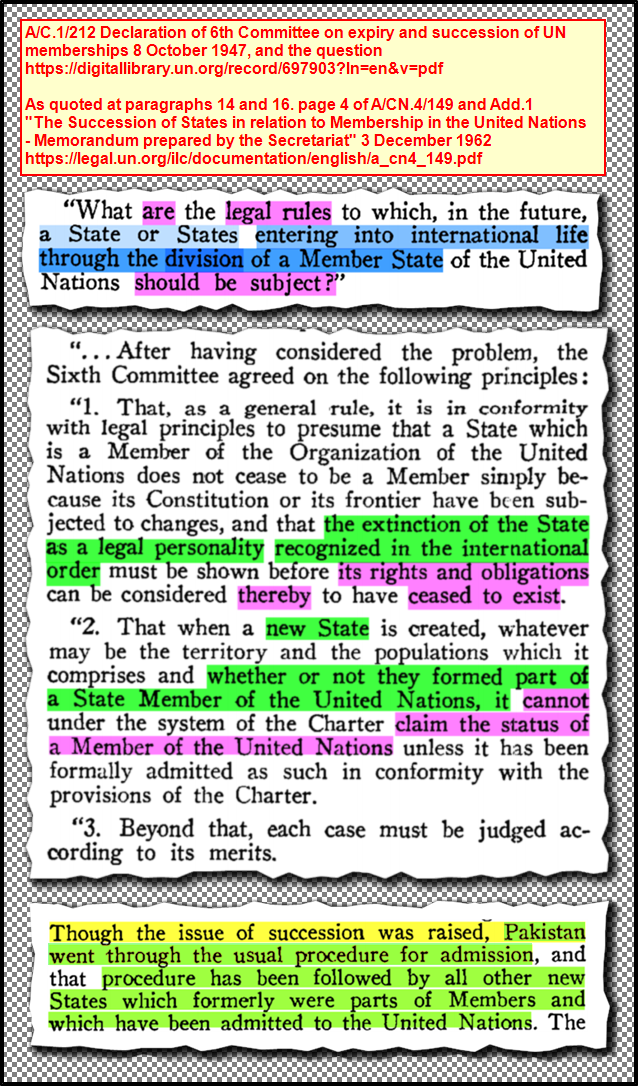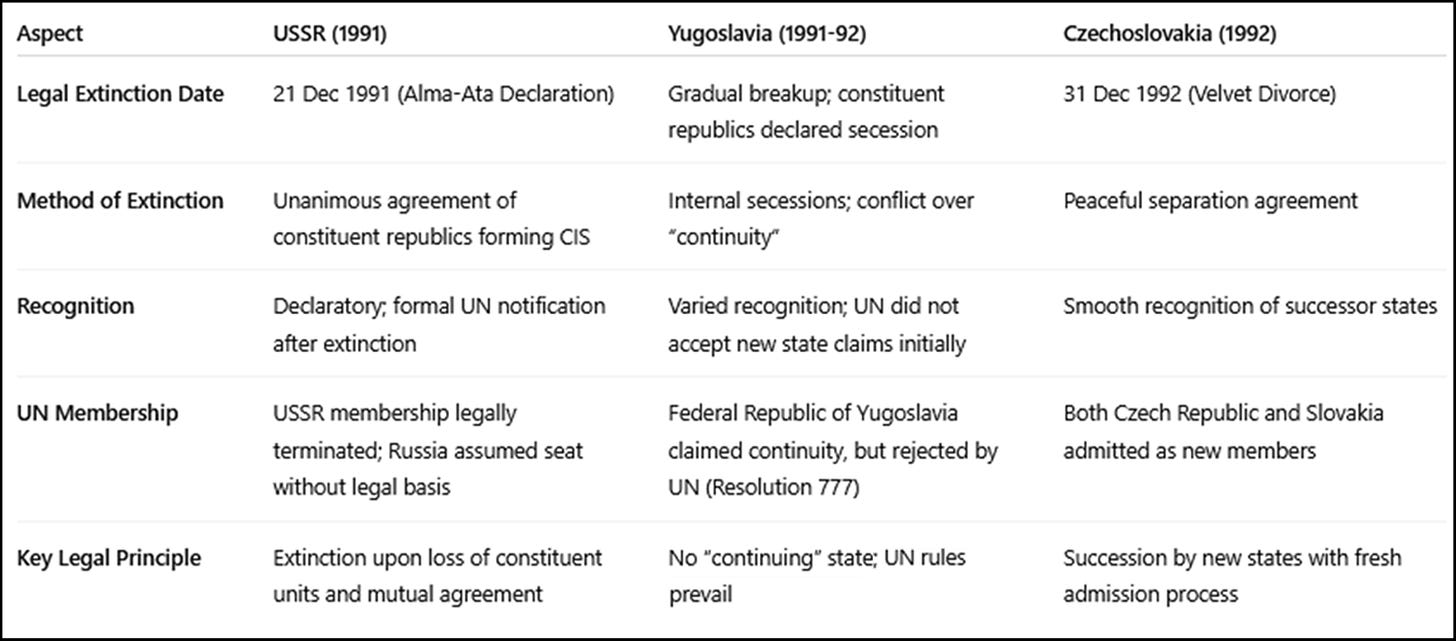The Date the USSR Legally Ended — Why Russia Could Not 'Continue' Its UN Memberships | Knowledge is Power
Yet another reason the Russian Federation cannot possibly be 'in' the United Nations. Debunking Kremlin lies ctd.
Yet another reason the Russian Federation cannot possibly be ‘in’ the United Nations. Debunking Kremlin lies ctd.
Audio playback link (play button is at top right): https://substack.com/home/post/p-164799613
A 6 minute overview by AI:
Contents
Background
Why 21 December 1991 is the real legal endpoint for the USSR as a state and a geopolitical entity
What happened on 25 December 1991
Did the secessions legally occur on the date the Alma-Ata Declaration was signed (21 Dec 1991), or only after it was ratified by national bodies? Did the declaration require ratification to take effect?
What Does International Law Actually Say About “Continuing” States?
Why the “Agreement of Successor States” Argument Fails
Background
Images - Russia and the UN | Knowledge Is Power traced the entire chronology of the Russian Federation and the USSR, and the law. We established that Boris Yeltsin’s letter dated 24 December 19911 “informing” the UN Secretary-General that Russia was “continuing” the USSR’s memberships was a nullity, and that Russia could not “continue” the USSR’s memberships on any possible view, namely:
Russia had never “been” the USSR.
Even if it had been, Russia had left the USSR and they were two separate unrelated countries by the time of Boris Yeltsin’s letter.
Even if it hadn’t left, the USSR’s memberships ceased to exist when the USSR did, so there was nothing to continue.
Even if the USSR’s memberships hadn’t ended, the UN Charter itself, and an explicit declaration of the law — which had been applied to the near identical case of Serbia, after Russia started illegally participating in the UN — ruled out any question of the USSR’s memberships surviving after it, and any question of succession or inheritance, under any circumstances.
Here we look at the academic question of whether the USSR had ceased to exist before or after Yeltsin’s letter. It’s irrelevant because even if the 4 irrefutable points above didn’t exist, and Yeltsin somehow “took over” or “assumed” the USSR’s memberships while it still existed, they subsequently ceased to exist. But it’s of interest, to close off yet another part of the Kremlin’s house of cards chicanery.
🗓 Why 21 December 1991 is the real legal endpoint for the USSR as a state and a geopolitical entity:
On 21 December 1991, at Alma-Ata (Almaty), 11 republics signed the Alma-Ata Declaration, which:
Formally confirmed the dissolution of the USSR;
Declared that the USSR no longer existed as a subject of international law;
Joined most of the republics that had remained in the USSR after Russia seceded on 12 December, into the Commonwealth of Independent States (CIS), a new organization of some of the former Soviet republics.
This meant that:
As of 21 December 1991, the USSR had no members remaining;
No republic remained bound by the USSR Treaty;
The legal identity of the USSR ended with this multilateral act of dissolution.
🗓 What happened on 25 December 1991?
This is not the date the USSR ceased to exist legally, but the date when:
Mikhail Gorbachev resigned as President of the USSR;
The USSR flag was lowered over the Kremlin and replaced by Russia’s flag.
So, 25 December is symbolic, not determinative of legal status. By that date, the USSR already no longer existed, and its dissolution had already been declared by its remaining constituent republics.
✅ Conclusion
The correct legal position is that the USSR ceased to exist as a state on 21 December 1991, upon the execution of the Alma-Ata Declaration by its remaining members.
From that point:
There was no union left for Russia to "continue";
Russia was not a member of any pre-existing state;
Any claim to continue the USSR’s UN membership lacked a legal basis, as there was no state left to continue.
❓ Did the secessions of the last 8 Soviet Republics legally occur on the date the Alma-Ata Declaration was signed (21 Dec 1991), or only after it was ratified by national bodies? Did the declaration require ratification to take effect?
✅ Short Answer:
The legal effect of secession and dissolution occurred on 21 December 1991, upon signature of the Alma-Ata Declaration by the remaining Soviet republics. Ratification was not required under either Soviet law or international law for the dissolution to take legal effect.
🔍 Detailed Legal Analysis:
1. Nature of the Alma-Ata Declaration (21 Dec 1991)

The declaration was:
A joint international agreement among 11 former Soviet republics, including Russia;
Explicit in stating that “the USSR as a subject of international law and a geopolitical reality has ceased to exist”;
A unanimous and mutual declaration of secession and state succession;
The founding document of the Commonwealth of Independent States (CIS).
Under international law, especially in cases of dissolution of federal unions (e.g. Yugoslavia, Czechoslovakia), such joint declarations between sovereign units are legally sufficient to terminate the former state's existence, without needing ratification.
2. Constitutional Law of the USSR:
By December 1991, the USSR Constitution had no supremacy over the constitutions of the republics.
Many republics had already declared independence unilaterally (e.g. Ukraine by referendum on 1 Dec 1991).
The USSR’s central government was non-functional and lacked authority to block or review secessions.
The Soviet system was based on the principle of voluntary union, and Article 722 of the USSR Constitution allowed republics to secede.
🧾 There was no constitutional requirement for ratification of secession by the central government or for inter-republic declarations to be ratified, to take effect.
3. International Law:
Per the 1991-1992 Badinter Commission (re: Yugoslavia), and general international law:
The existence or disappearance of a State is a question of fact.
The effects of recognition by other states is purely declaratory.
When all members of a Federal State have become independent, and are no longer participating jointly in the common Federal administration, its organs no longer exist or function, and there is no territory or population under the sovereign authority of the Federal State, it no longer exists.
No ratification is required for the termination of the union if the highest organs or representatives of all constituents act, whether separately or together.
4. Post-Declaration Conduct Confirms Legal Effect:
Immediately after 21 December, the republics:
Acted as sovereign states internationally;
Established embassies independently;
Signed treaties,
Withdrew from Soviet bodies;
Began independent UN membership applications (except Russia, which improperly claimed continuity).
No ratification followed, because the signatories themselves were the highest competent authorities (presidents or prime ministers of republics), acting on behalf of fully sovereign republics.
🧭 Conclusion:
The USSR’s legal dissolution occurred on 21 December 1991, when the Alma-Ata Declaration was signed.
No ratification was needed, because:
The signatories were sovereign representatives;
No higher ratifying body existed or was required by law;
Practice, precedent, and international recognition followed immediately.
Any attempt to backdate, delay, or defer the legal effect beyond 21 December is without legal basis and typically advanced only to support post hoc rationalizations of Russia’s illegal UN claim.
Does ‘recognition in the international order’ need to be shown before memberships cease to exit?
The 1947 Declaration on the Rights and Duties of States (adopted by the UN International Law Commission)3, provides that:
“The extinction of the State as a legal personality recognized in the international order must be shown before its rights and obligations can be considered thereby to have ceased to exist.”
This raises the an issue of when rights and obligations under international law cease for a dissolved or extinct state, particularly in the context of recognition by the international community (notably the UN), and whether recognition is constitutive or declaratory of extinction.
🔍 Legal Framework and Jurisprudence
1. Extinction of a State: Legal vs. Evidentiary Threshold
Under international law, a state ceases to exist when it no longer possesses the essential attributes of statehood:
Permanent population
Defined territory
Government
Capacity to enter into relations with other states (Montevideo Convention, 1933)
A state’s legal extinction is not delayed by lack of recognition or by delay in notifying international organizations like the UN.
2. Recognition Is Declaratory, Not Constitutive
Recognition of state extinction is not a legal precondition for that extinction to take effect.
This principle was confirmed in the Badinter Commission opinions (1991–92), where recognition was seen as acknowledging an already existing fact, not creating it.
Similarly, the dissolution of Czechoslovakia (1992) and Yugoslavia (1991–92) were treated as legal facts effective upon agreement between the constituent units, not upon UN acknowledgment.
3. The Alma-Ata Declaration's Legal Effect Preceded UN Circulation
The Alma-Ata Declaration (21 Dec 1991) clearly stated that the USSR “ceased to exist”.
It was signed by the sovereign representatives of the remaining republics, including Russia, and represented a binding legal agreement of dissolution.
Although circulated to the UN on 30 December 1991, the legal effect was immediate upon signature.
4. The USSR's International Personality Ended on 21 December 1991
The USSR had no remaining constituent units after 21 December (following Russia and the other republics forming the CIS and declaring the USSR extinct).
No organ of the USSR continued to function after 25 December (Gorbachev resigned, and the Presidency of the USSR was abolished).
The Council of Republics of the Supreme Soviet adopted a resolution on 26 December acknowledging the end of the USSR’s existence.
These steps confirmed, rather than caused, the dissolution, and had no independent legal power to prolong the USSR’s personality.
🧾 Answer to the Question:
Did the USSR’s international rights and obligations cease only once the Alma-Ata Declaration was circulated at the UN (30 Dec), or did they cease on the date of actual extinction (21 Dec)?
They ceased on 21 December 1991, the date of the Alma-Ata Declaration, which constituted the legal extinction of the USSR as a subject of international law.
The 30 December circulation was merely notice of an already accomplished legal fact.
There is no legal principle requiring delay in the cessation of international obligations pending recognition or notification.
Article 77 of the Vienna Convention on the Law of Treaties (1969) requires notice of state succession “without delay”, but this does not affect the date of legal effect.
⚖️ Summary
The USSR’s international rights and obligations ceased as of 21 December 1991, when all remaining constituent republics declared and agreed that it had ceased to exist.
The UN was notified later, but that does not affect the legal date of extinction.
The 1947 Declaration affirms that extinction must be internationally recognised— this was done conclusively by the copy of the Alma Ata Declaration issued as a UN document and circulated on 30 December 1991.
There is no basis under international law for continuing rights or obligations after the extinction of legal personality, merely due to delay in notification.
Summary So far: Legal Date of Extinction of the USSR and Consequences for UN Membership and International Rights and Obligations
I. Issue
What is the legal date on which the USSR ceased to exist as a subject of international law, thereby terminating its rights and obligations, including its UN membership? Does the circulation of the Alma-Ata Declaration at the UN on 30 December 1991 affect this date? What is the relevance of subsequent acts such as Gorbachev’s resignation and the 26 December resolution of the USSR’s Supreme Soviet?
II. Relevant Law and Principles
Attributes of Statehood:
A state ceases to exist when it no longer possesses the essential attributes of statehood (permanent population, defined territory, government, capacity to enter into relations with other states) (Montevideo Convention, 1933).1947 UN Declaration on Rights and Duties of States (reaffirmed by the International Law Commission):
“The extinction of the State as a legal personality recognized in the international order must be shown before its rights and obligations can be considered thereby to have ceased to exist.”Recognition:
Recognition of extinction by other states or international bodies is declaratory, not constitutive; extinction occurs as a legal fact irrespective of recognition (Badinter Commission Opinions, 1991–1992).Vienna Convention on the Law of Treaties (1969), Article 77:
Requires prompt notification of succession in respect to treaties but does not affect the date of legal extinction.
III. Factual Background
Alma-Ata Declaration (21 December 1991):
Signed by the presidents of 3 former and8 remaining Soviet republics declaring the USSR to have ceased to exist and establishing the Commonwealth of Independent States (CIS).Gorbachev’s Resignation (25 December 1991):
Formal resignation as President of the USSR, signaling the final act of dissolution.USSR Supreme Soviet Resolution (26 December 1991):
Acknowledged the dissolution of the USSR.UN Circulation of Alma-Ata Declaration (30 December 1991):
Official notice given to the UN Secretariat 27 December; circulated to all UN member states.
IV. Legal Analysis
Date of Extinction:
The USSR legally ceased to exist on 21 December 1991 upon the Alma-Ata Declaration, when all remaining republics (including Russia) agreed to its dissolution, fulfilling the criteria of loss of constituent units and sovereign will to continue.Effect of Subsequent Acts:
Gorbachev’s resignation and the Supreme Soviet’s resolution were confirmation of the already established legal fact and did not create or delay extinction.
The Supreme Soviet had become a nominal body, unable to restore the USSR as a legal personality.
Notification vs. Legal Effect:
The circulation to the UN on 30 December 1991 was a notification and recognition of the legal fact; recognition and notification do not determine the date of cessation.
International law treats extinction as effective upon the act that fulfills extinction conditions, not upon the later acknowledgment.
Consequences for UN Membership:
The USSR’s rights and obligations, including UN membership, terminated on 21 December 1991.
Any claim by Russia to “continue” the USSR’s membership after that date conflicts with the fact of extinction.
V. Conclusion
The USSR ceased to exist as a legal entity on 21 December 1991, the date of the Alma-Ata Declaration. The cessation of its rights and obligations—including UN membership—occurred at that time, independently of later notification or political acts. This conclusion is supported by general principles of international law, state succession doctrine, and consistent with prior precedents.
Comparative Summary: USSR, Yugoslavia, and Czechoslovakia
See the table below.
Notable Points
USSR vs. Yugoslavia:
The USSR continued to exist nominally until 21 December 1991 with constituent republics signing the dissolution agreement; Russia formally left the USSR before its final extinction, undermining claims of continuity. In contrast, Yugoslav republics did not agree on a dissolution or successor state; all states except Serbia and Montenegro left and claimed the Socialist Federal Republic of Yugoslavia (SFRY) was dissolved. Serbia and Montenegro claimed to continue the SFRY under the name the Federal Republic of Yugoslavia, pursuant to a joint declaration with the old Federal Republic. The UN rejected their claim to continuity (UN SC Resolution 777, General Assembly Resolution A/RES/47/1).USSR vs. Czechoslovakia:
The Czechoslovakia breakup was peaceful and mutually agreed, with new states admitted as new members under Article 4 of the UN Charter. There was no claim of “continuity”. The extinction of Czechoslovakia was accepted.UN Legal Practice:
"Thereby" in the 1947 Declaration refers to the extinction of the state, not the recognition of it. UN membership requires compliance with Article 4 procedures; continuation is not possible upon state dissolution.The idea that a “continuing state” can be established merely by agreement among non-UN successor states is legally flawed and has no basis in the UN Charter or established international law.
On the Kremlin's argument about "continuing seats", Palestine could stroll up to the UN S-G and "inform" him that it was "continuing" Czechoslovakia's membership!
UN memberships and Security Council permanent memberships are not “seats” that you can just take over or inherit by fiat. They are legal memberships of sovereign states—each named and distinct.
If “continuity” or “succession” could be claimed simply by one entity informing the UN Secretary-General that it’s now “continuing” a prior member’s membership, then, hypothetically, any entity—like Palestine—could claim Czechoslovakia’s membership by the same logic. That’s obviously nonsense under international law and UN practice.
Membership requires strict compliance with the UN Charter’s admission procedures and cannot be transferred or assumed unilaterally. The Kremlin argument ignores this fundamental legal fact.
📌 What Does International Law Actually Say About “Continuing” States?
1. The concept of a “continuing” state is extremely narrow.
It applies only in cases where the original state continues to exist as a legal person—meaning:
No break in legal personality.
No cessation or extinction of the state.
Continuity of UN membership does not depend on uninterrupted institutions, government, or territory, but on the continued existence of the state’s international legal personality. A state may undergo internal political or territorial changes and still remain a member, so long as it has not ceased to exist as a subject of international law.
That was the case with India (after Pakistan’s secession) and with the People’s Republic of China (when replacing the Republic of China in the UN after civil war, not succession). These are not examples of successor or breakaway states “agreeing” to continuity—they are examples of the original entity never having ceased to exist.


✅ What Actually Constitutes Continuity of Statehood for UN Membership (per 1947 Declaration)
“A Member of the Organization of the United Nations does not cease to be a Member simply because its Constitution or its frontier have been subjected to changes.”
This means:
Changes in form of government, such as revolution, civil war, or transition from monarchy to republic, do not end membership.
Changes in territory, such as secession or border adjustments, also do not terminate membership — provided the legal personality of the original state continues.
What does terminate UN membership is the extinction of the state as a subject of international law — i.e., the complete dissolution or disappearance of its legal personality, not merely changes of its institutions.
🛑 Why the “Agreement of Successor States” Argument Fails

There is no legal provision in the UN Charter or general international law that permits:
Non-members (such as newly independent former parts of a UN member)
To jointly designate another state as the “continuing” UN member in their place
And override the admission procedures of Article 4 of the Charter.
That concept violates the UN’s legal framework, which does not allow succession to membership.
In particular:
UNSCOR Supplement (1947) and the 1947 Declaration on Membership in Cases of Dissolution or Division make clear:
There is no succession to membership in the United Nations. Membership attaches to the international personality of the state.
The only way to become a member is to be admitted under Article 4, not declared one by “agreement.”
Pakistan did not need to “agree” for India to continue. India was the continuing entity by default, as it remained, while Pakistan seceded from it.
⚖️ Application to Russia–USSR Case
In the Russia–USSR scenario:
Russia seceded from the USSR on 12 December 1991.
The USSR continued to exist with 8 republics until 21 December 1991.
Russia was not the, or a, continuing state — it was a breakaway.
The other republics had no legal power to “designate” Russia as the “continuing state.” To suggest that 11 out of 15 former Soviet Republics, only two of them even members of the UN, could decide that a country would be a member of the UN, is a nonsense.
There is no legal precedent or Charter authority to override the mandatory Article 4 process by such an “agreement.”
✅ Conclusion
Continuity is a matter of legal fact, not consent.
No agreement between successor or third-party states can override Charter rules.
UN Charter provisions prevail, and membership cannot be “inherited” or “passed on” by agreement.
The “agreement” argument is another piece of Kremlin legal fiction—unsupported by law, logic, or precedent.
Final fun fact:
The noise about political support from some ex soviet states has obscured the fact that the USSR itself did not even consent to, let alone support, Russia “continuing” its UN memberships. Although it would not have made any difference if it had: Serbia’s identical claim to “continue” the membership of its federal umbrella state of Yugoslavia was refused by both the UN Security Council and General Assembly, despite
the provision by the Socialist Federal Republic of Yugoslavia of its written agreement—and,
Serbia and Montenegro had neither broken away, nor declared it didn’t exist—as Russia had done.
These 3 differences simply highlight the ridiculousness of Russia’s claim. And make a nonsense of the frequently heard excuse that it merely “didn’t follow the correct procedure”. There was no “correct procedure” to do something which was impossible - “continue” UN memberships of another state.
Had Russia actually followed the “correct procedure” — an application for membership — it would have failed: it was in aggressive non-consented military occupation in 6 other UN member states at the time. And that, of course, is why, like Serbia, it tried to bypass the correct procedure.
Now you know the truth, sign the petition!
#RussiaUNFraudPetition.
Petition to Kick Russia Out of the United Nations - the CORRECT procedure, can't be vetoed, no reform needed | Knowledge is Power
This is the #RussiaUNFraudPetition. Evidence hidden for 3 decades now removes all doubt — Russia is not a member of the United Nations. OUR OWN governments are violating the UN Charter. Allowing a terrorist to eviscerate the world’s most powerful military alliance. Supposed to protect OUR human rights, sovereignty, and territorial integrity. Easily fixe…
NEXT: Full details, step by setp:
Images - Russia and the UN
The video and documents proving Russia is not in the UN, and its representatives can be expelled by a simple majority (of members present and voting, abstentions aren’t counted) resolution of the UN General Assembly, within a week. No veto, no "reform".
Yeltsin’ letter dated 24 December 1991:

Last USSR Constitution The Constitution of the USSR as amended on December 26, 1990
1947 UN General Assembly Declaration of the Law on Succession in Relation to UN Memberships on Division and Extinction of Member States, affirming the 1947 Secretariat Legal Opinion, affirming and citing pre-existing International Law
As set out in the UN International Law Commission Yearbook for 1962, Vol II “SUCCESSION OF STATES AND GOVERNMENTS
, DOCUMENT A/CN.4/149 AND ADD.l
‘The succession of States in relation to membership in the United Nations: memorandum prepared by the Secretariat“
(Annotated and redacted to the introduction and the relevant rulings, for clarity)
Note the use of the word “continue” and its meaning and context:












